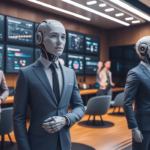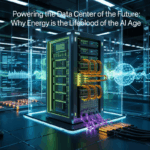When discussing artificial intelligence (AI), many immediately think of Graphics Processing Units (GPUs) as the critical hardware driving this technology. However, while GPUs play a pivotal role in AI workloads, it’s important to recognize that the infrastructure supporting AI extends far beyond just GPUs. The performance and scalability of AI applications also hinge on factors like data center architecture, which has become increasingly specialized to meet the demands of modern AI.
Here’s how AI is reshaping data centers:
Network Infrastructure
The communication between GPUs is just as important as the performance of the individual GPUs themselves. High-performance, low-latency networking is essential to ensure that GPUs can communicate quickly and efficiently. This means data centers must adopt advanced interconnects, such as InfiniBand or NVLink, to facilitate the rapid transfer of data across multiple nodes without bottlenecks. This infrastructure is especially critical for large-scale AI models that require parallel computing across multiple GPUs and servers.
Power and Cooling
The surge in AI workloads has brought a significant increase in power consumption and heat generation. AI hardware, particularly clusters of GPUs, requires much more power than traditional data center setups. As a result, data centers must be equipped with high-density power systems and innovative cooling technologies to maintain optimal operating temperatures. Liquid cooling solutions are becoming more common as air cooling alone is often insufficient for the high power densities required by AI systems. Liquid cooling not only improves efficiency but also reduces energy consumption in cooling operations.
Data Center Layout
The traditional design of data centers is being transformed to meet the unique demands of AI workloads. Specialized data halls, which can accommodate AI hardware like GPU clusters and flexible rack configurations, are essential. These designs allow data centers to support a variety of AI workloads, from deep learning to real-time inference. Flexible layouts also ensure that different kinds of processing units, such as Tensor Processing Units (TPUs) and Field-Programmable Gate Arrays (FPGAs), can be integrated and scaled according to specific workload needs.
Management and Automation (AI for AI)
One of the most exciting developments is the use of AI to manage AI workloads. AI-driven automation tools can optimize data center operations by monitoring system performance, predicting maintenance needs, and dynamically managing resources based on the changing demands of AI tasks. This not only improves efficiency but also ensures that data centers can scale up or down as necessary without manual intervention.
Scalability
AI workloads are growing rapidly, and so is the need for scalable solutions. Modular designs in data centers allow for incremental expansion, ensuring that the infrastructure can grow alongside AI demands. Additionally, edge computing—processing data closer to the source rather than relying solely on centralized data centers—is becoming more critical as AI applications become more distributed. By leveraging edge computing, data centers can handle real-time AI workloads, reducing latency and bandwidth usage.
Artificial intelligence is reshaping data center architecture, making it clear that successful AI deployment requires more than just powerful GPUs. As AI continues to evolve, so too must the infrastructure that supports it, from networking and cooling solutions to flexible layouts and AI-driven automation. The future of AI will be built on scalable, efficient, and smart data centers designed to handle the unique challenges posed by this transformative technology.









